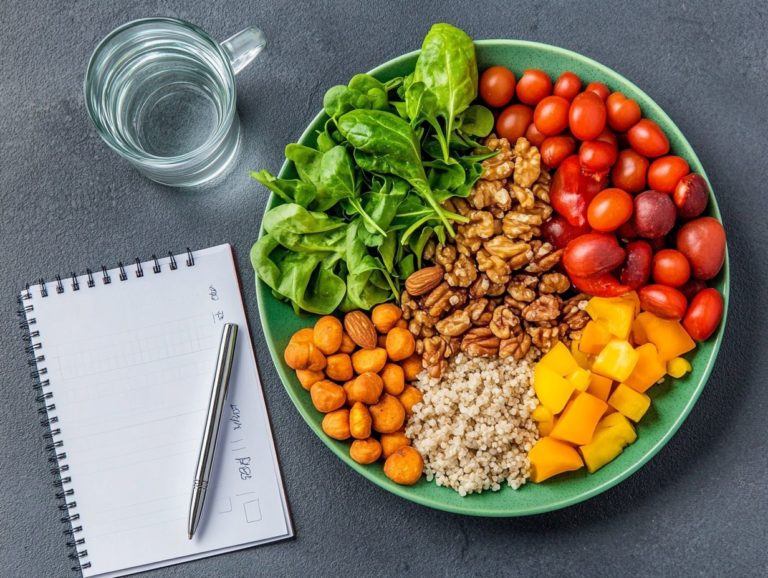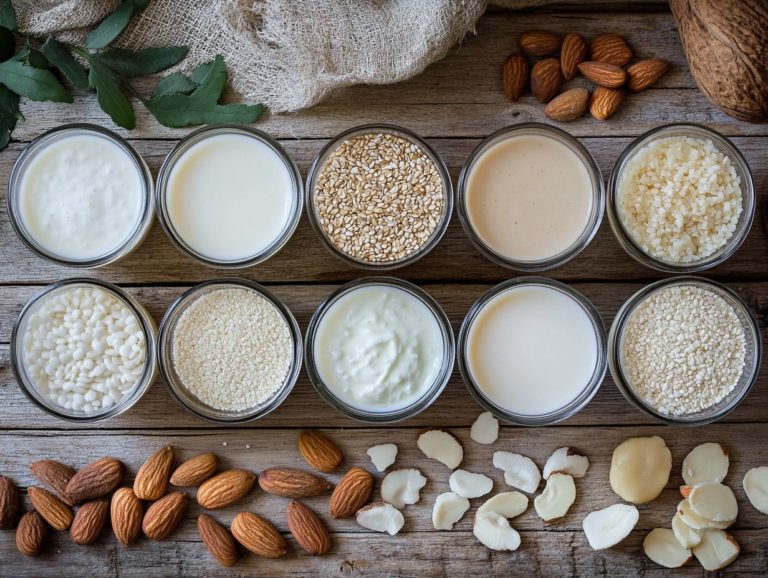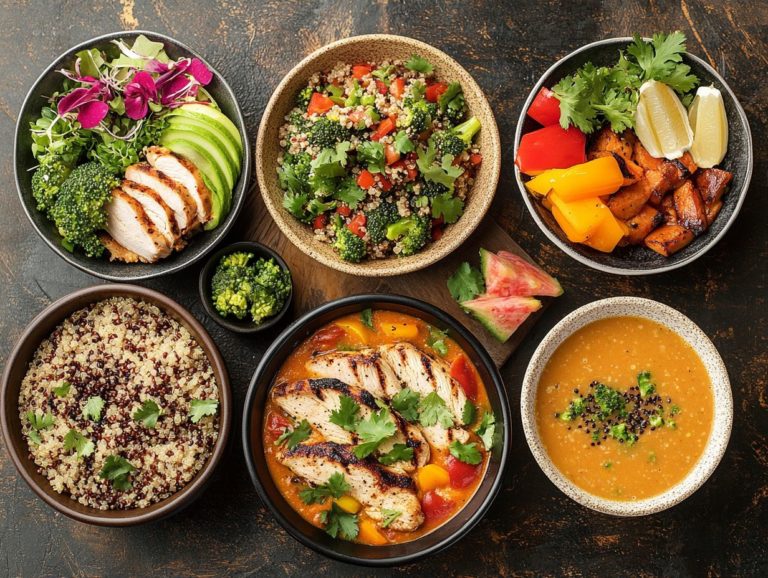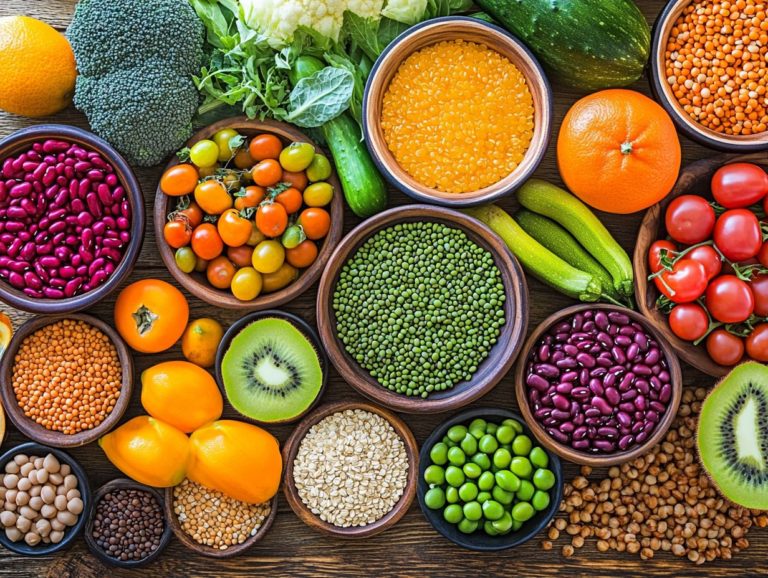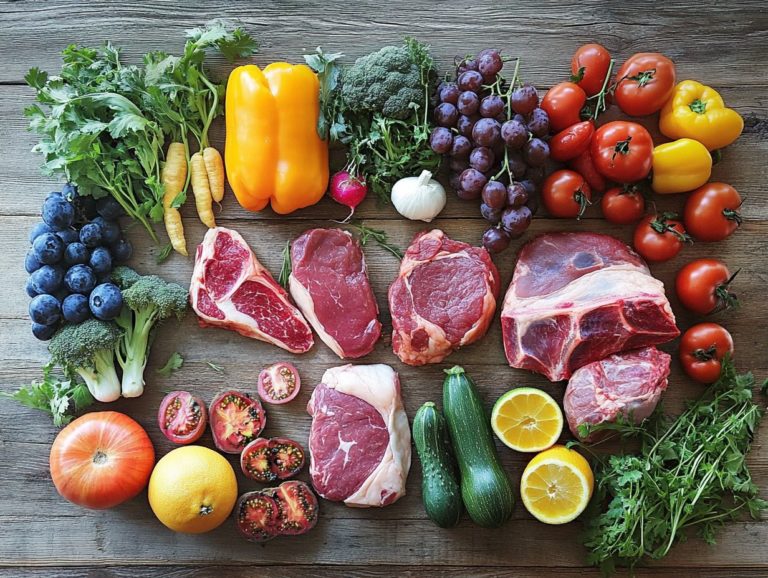7 Low-Gluten Recipes for Healthier Eating
Are you ready to embrace a healthier lifestyle without compromising on flavor?
This article offers seven delectable low-gluten recipes that turn nutritious eating into an enjoyable experience. From vibrant stir-fries to indulgent desserts, these dishes are designed to delight your taste buds while keeping gluten at bay.
Discover what gluten is, its potential impacts on your health, and how to easily incorporate these wholesome meals into your daily diet. Get excited to discover delicious, gluten-free meals!
Contents
- Key Takeaways:
- 1. Gluten-Free Chicken and Vegetable Stir-Fry
- 2. Quinoa and Black Bean Salad
- 3. Zucchini Noodles with Pesto
- 4. Gluten-Free Turkey Meatballs and Spaghetti Squash
- 5. Cauliflower Crust Pizza
- 6. Almond Flour Banana Bread
- 7. Gluten-Free Chocolate Chip Cookies
- Understanding Gluten: Why Cutting Back Can Boost Your Health!
- What Are the Benefits of a Low-Gluten Diet?
- What Are Some Common Sources of Gluten in the Diet?
- How Can You Make Healthy Substitutions for Gluten in Recipes?
- Is a Low-Gluten Diet Suitable for Everyone?
- How Can You Incorporate More Low-Gluten Recipes into Your Diet?
- What Are Some Tips for Successfully Following a Low-Gluten Diet?
- Frequently Asked Questions
- What are low-gluten recipes for healthier eating?
- Why should I consider incorporating low-gluten recipes into my diet?
- What types of ingredients are used in low-gluten recipes?
- Are these recipes suitable for those with celiac disease?
- Can these recipes help with weight loss?
- Do these recipes sacrifice flavor for health?
Key Takeaways:
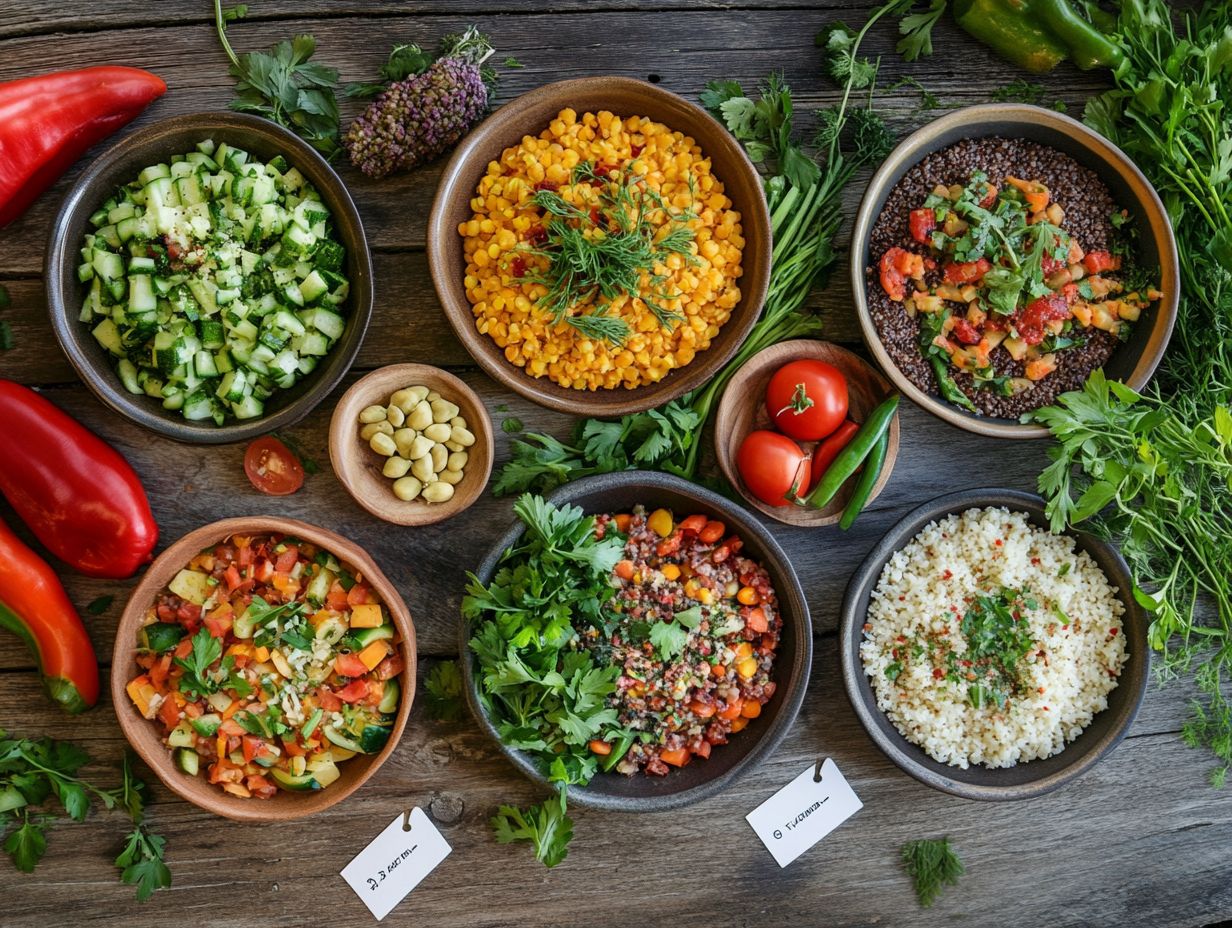
Incorporate more vegetables and lean proteins into your diet with recipes like gluten-free stir-fry and zucchini noodles to promote better health.
Try replacing traditional grains with quinoa and black beans for a nutrient-dense and gluten-free salad.
Satisfy your pizza and pasta cravings with healthier alternatives like cauliflower crust and spaghetti squash.
1. Gluten-Free Chicken and Vegetable Stir-Fry
Gluten-Free Chicken and Vegetable Stir-Fry is a vibrant and wholesome dish made for those who are gluten-sensitive. It s an excellent choice whether you have celiac disease or simply seek healthy meal ideas.
This colorful creation combines fresh vegetables like bell peppers, broccoli, and carrots, delivering essential vitamins and minerals that nourish your body. Lean chicken offers a protein boost, ensuring the dish is satisfying and supportive of muscle repair.
To keep it gluten-free, swap traditional soy sauce for gluten-free tamari or coconut aminos, accommodating your dietary needs. As Alex Loh wisely noted, “Eating fresh is the key to feeling vibrant,” and this stir-fry embodies that philosophy.
It s a quick, customizable dish that can bring your family together for a healthy meal everyone will relish.
2. Quinoa and Black Bean Salad
Quinoa and Black Bean Salad is a nutrient powerhouse that balances protein and fiber, making it the perfect gluten-free choice for lunch or dinner. This is especially beneficial if you’re navigating gluten sensitivity or celiac disease.
This dish is packed with essential amino acids and vitamins that support muscle recovery while keeping your hunger at bay. The blend of quinoa and black beans provides a complete protein source. You can elevate the dish by adding seasonal vegetables like bell peppers, zucchini, or roasted corn to enhance flavor and nutrition.
For an extra kick, drizzle a zesty lime vinaigrette or a simple olive oil and balsamic dressing over the top, ensuring each bite bursts with gluten-free goodness.
Try experimenting with fresh herbs like cilantro for a vibrant twist that adds another layer of depth to this delightful salad!
3. Zucchini Noodles with Pesto
Zucchini Noodles with Pesto is a refreshing gluten-free dish that transforms traditional pasta into a low-carb, healthy option. This is perfect for you if you’re navigating gluten sensitivity or celiac disease and are looking for flavorful meal ideas.
By spiralizing zucchini, you cut down on carbohydrates while introducing an array of nutrients, including vitamins A and C, along with fiber.
This vibrant dish can be elevated with your choice of homemade pesto, which offers a fresher flavor that surpasses store-bought versions. If you want to make it heartier, add protein sources like grilled chicken or saut ed shrimp.
This not only enhances the dish s nutritional profile but also adds delightful textures and flavors, ensuring that every bite is satisfying and complete. Please share your own variations or experiences with this dish!
4. Gluten-Free Turkey Meatballs and Spaghetti Squash
Gluten-Free Turkey Meatballs paired with Spaghetti Squash is a healthy and filling dish that caters not only to those with celiac disease but also to anyone eager to indulge in delicious, gluten-free recipes.
You can whip up these delightful meatballs using almond flour or gluten-free breadcrumbs, both of which lend a wonderful texture and elevate the flavor.
If you re new to spaghetti squash, roasting it until tender reveals lovely, spaghetti-like strands that make for an excellent substitute for traditional pasta.
These gluten-free meatballs shine with a variety of sauces. Marinara or pesto can truly elevate the dish, and a sprinkle of fresh herbs adds a burst of flavor that s hard to resist.
This combo hits the spot whether it s lunch or dinner, satisfying your cravings for a health-conscious meal without skimping on taste.
5. Cauliflower Crust Pizza
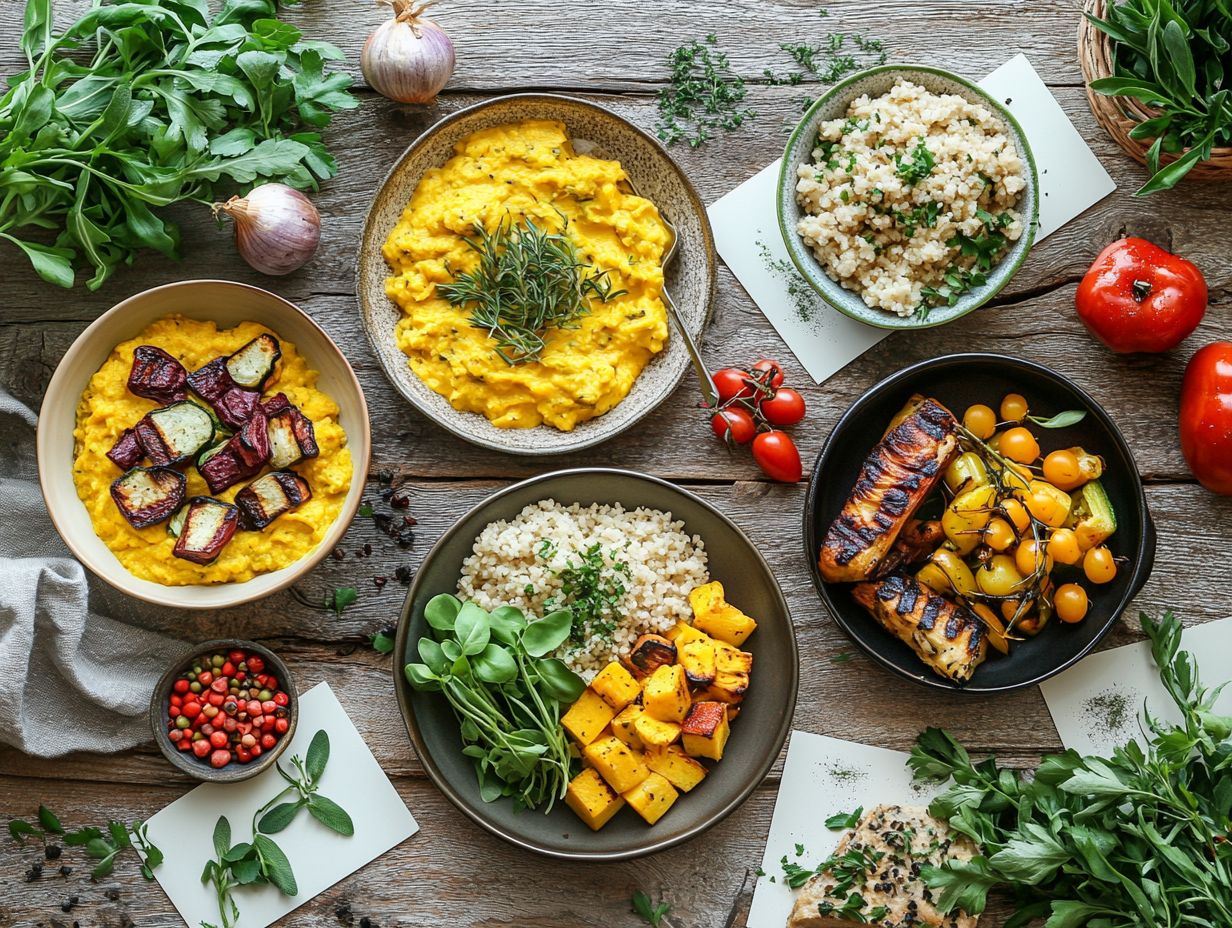
Cauliflower Crust Pizza provides a delightful gluten-free alternative to traditional pizza. It’s perfect for those with gluten sensitivity or celiac disease who still yearn for a delicious, healthy meal.
This innovative dish starts with finely grating fresh cauliflower, steaming it, and then squeezing out the excess moisture to achieve that perfect consistency.
Once mixed with binding ingredients like eggs and cheese, it creates a satisfying crust packed with vitamins and fiber. Adding vegetables not only enhances the nutritional profile but also supports your weight management goals and overall well-being.
For topping inspiration, consider vibrant roasted vegetables, fresh basil, and a zesty marinara sauce. You might also add lean proteins like grilled chicken or turkey pepperoni. These combinations cater to gluten-free diets while ensuring a balanced meal that’s bursting with flavor.
6. Almond Flour Banana Bread
Almond Flour Banana Bread is a moist and flavorful gluten-free delight that satisfies your sweet cravings while supporting those navigating a gluten sensitivity or celiac disease diet without compromising on taste or texture.
This versatile ingredient brings a wealth of nutritional benefits, including healthy fats, protein, and essential vitamins like vitamin E, all contributing to your overall wellness.
By swapping traditional flour for almond flour, you can create delightful desserts for both health-conscious individuals and those with dietary restrictions.
Enhancing the flavor profile is a breeze; toss in some chopped nuts for a satisfying crunch, or add rich chocolate chips for an indulgent touch.
The result? A gluten-free experience that is utterly delicious. With these variations, you can enjoy a slice without a hint of guilt.
7. Gluten-Free Chocolate Chip Cookies
Gluten-Free Chocolate Chip Cookies offer a delightful indulgence, allowing you to savor a classic dessert without compromising your dietary needs, especially if you have gluten sensitivity or celiac disease.
By exploring a variety of gluten-free flour blends like almond flour, oat flour, or even a quality store-bought mix you can achieve different textures and flavors that enhance your overall cookie experience.
These alternatives also boast nutritional benefits; for instance, almond flour brings a higher protein content to the table, while oat flour is a fantastic source of fiber.
To master that perfect chewy yet soft texture, combine these flours and adjust the liquid content, as gluten-free flours tend to absorb more moisture.
If you’re feeling adventurous, swap out butter for coconut oil to introduce healthy fats. And let s not forget dark chocolate chips they not only elevate the flavor but also pack a punch of antioxidants, making these cookies a more wholesome treat.
Don t wait! Try these delicious recipes today for a scrumptious gluten-free feast!
Understanding Gluten: Why Cutting Back Can Boost Your Health!
Gluten is a protein lurking in wheat and related grains that can pose serious health risks for those diagnosed with celiac disease or experiencing gluten sensitivity. Because of this, many individuals choose to limit or completely eliminate gluten from their diets in pursuit of better health outcomes.
For those with celiac disease, gluten can trigger an autoimmune response that harms the intestinal lining. This leads to poor absorption of nutrients and various uncomfortable symptoms like bloating, diarrhea, and fatigue.
Research shows that approximately 1 in 100 people globally are affected by celiac disease, while gluten sensitivity may impact an additional 6-7% of the population. This growing awareness has sparked a significant rise in gluten-free diets, with market research projecting that the gluten-free food industry will surpass $30 billion by 2026.
This reflects a clear shift toward gluten-conscious eating habits among consumers everywhere.
What Are the Benefits of a Low-Gluten Diet?
A low-gluten diet can bring you a host of benefits, including reduced inflammation, improved digestion, and increased energy levels especially if you have gluten sensitivity or celiac disease.
Imagine feeling more energetic and experiencing less inflammation! Many people have transformed their health by choosing a low-gluten diet.
Many have shared inspiring stories about how this dietary shift transformed their health. For example, one recent testimonial revealed that after just weeks on a low-gluten regimen, they experienced a remarkable reduction in joint pain and bloating issues that had persisted for far too long.
Nutritionists often emphasize how these dietary changes are important, pointing out that cutting out gluten can enhance nutrient absorption and boost mental clarity. Health experts suggest that moving away from gluten could lower the risk of gastrointestinal disorders, making it a compelling option for anyone grappling with chronic digestive challenges.
What Are Some Common Sources of Gluten in the Diet?
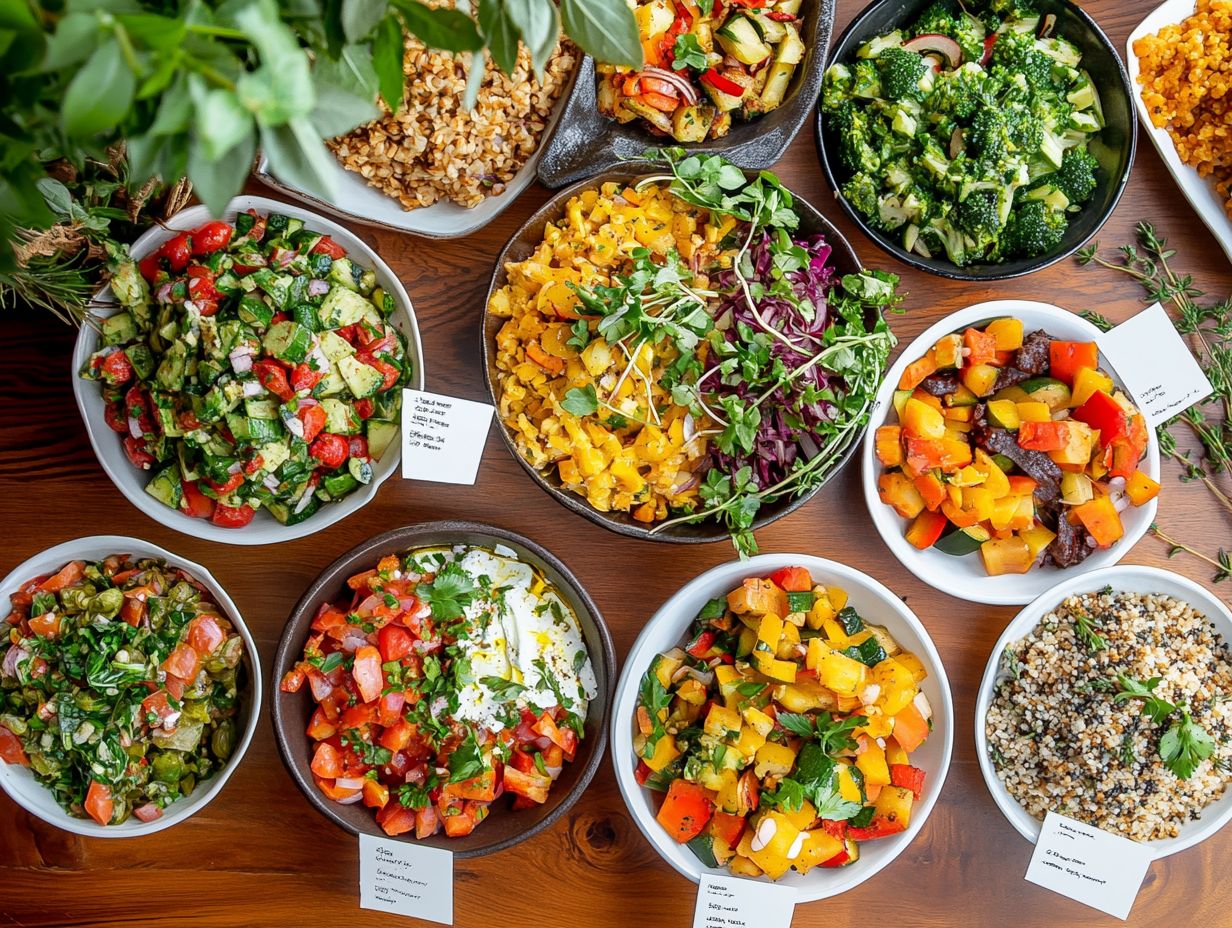
Common sources of gluten in your diet include:
- Bread
- Pasta
- Many processed foods
For individuals with gluten sensitivity or celiac disease, it s essential to identify gluten sources quickly and eliminate these items from their meals.
Gluten can often lurk in unexpected places, such as sauces, dressings, and even certain snacks like chips and granola bars. This makes it crucial for you to read labels meticulously, as manufacturers frequently incorporate gluten-containing ingredients as thickening agents or flavor enhancers.
To navigate your daily eating routines with ease, consider planning meals centered around whole foods. Focus on:
- Fruits
- Vegetables
- Meats
- Gluten-free grains like quinoa and rice
When you’re in need of a snack, opting for raw nuts or homemade energy bites ensures your options remain gluten-free while keeping your diet varied and interesting.
How Can You Make Healthy Substitutions for Gluten in Recipes?
Making healthy substitutions for gluten in your recipes can be both simple and rewarding, providing you with flavorful alternatives that cater to gluten sensitivity or celiac disease.
By incorporating gluten-free ingredients like almond flour, quinoa, or buckwheat, you can easily elevate the nutritional profile of your meals.
For example, almond flour can seamlessly replace traditional wheat flour in your baking, resulting in moist and rich treats like cookies and cakes that you’ll love.
Quinoa, with its unique nutty flavor, serves as a fantastic base for salads or a hearty side dish, adding a delightful texture to your table.
Buckwheat is another excellent option; you can use it in pancakes or porridge, creating a wholesome breakfast choice that’s both filling and gluten-free.
These substitutions not only accommodate dietary restrictions but also invite new tastes and textures into your cooking, transforming every dish into a culinary adventure.
Is a Low-Gluten Diet Suitable for Everyone?
A low-gluten diet can benefit individuals with gluten sensitivity or celiac disease. However, it may not be necessary for everyone. Understanding your unique dietary needs is crucial for optimal health.
For those without gluten-related disorders, eliminating gluten might lead to nutritional deficiencies, as many gluten-containing foods are rich in essential vitamins and minerals. You might end up choosing processed gluten-free alternatives, which often lack the benefits of whole grains.
If you’re thinking about this dietary change, it’s wise to review your health and discuss your plans with a healthcare provider. This ensures that any changes you make are customized to your needs, ultimately supporting your well-being.
How Can You Incorporate More Low-Gluten Recipes into Your Diet?
Incorporating low-gluten recipes can be an exciting culinary journey. You’ll discover new flavors while accommodating gluten sensitivity or celiac disease.
Start with meal planning. Dedicate time each week to explore cookbooks or websites focused on gluten-free cooking. You’ll find a wealth of resources that provide low-gluten recipes and tips for substituting traditional ingredients.
Experiment with gluten-free grains like quinoa or brown rice to create exciting new meals. Transitioning to gluten-free versions of everyday staples can add variety and taste to your cooking.
What Are Some Tips for Successfully Following a Low-Gluten Diet?
Navigating a low-gluten diet requires dedication and awareness. With the right tips, you can thrive on a gluten-free lifestyle, especially if you have gluten sensitivity or celiac disease.
Mastering label reading is essential. Scrutinize packaged foods for hidden sources of gluten, leaving no stone unturned.
Meal prepping is key to your success. Planning your meals in advance helps eliminate the temptation to choose non-compliant options.
Incorporating tasty gluten-free snacks like fresh fruits, nuts, or specially crafted bars can keep you energized while curbing cravings.
Engage with a supportive community online or in-person. Shared experiences are invaluable for navigating the complexities of a low-gluten lifestyle.
Frequently Asked Questions
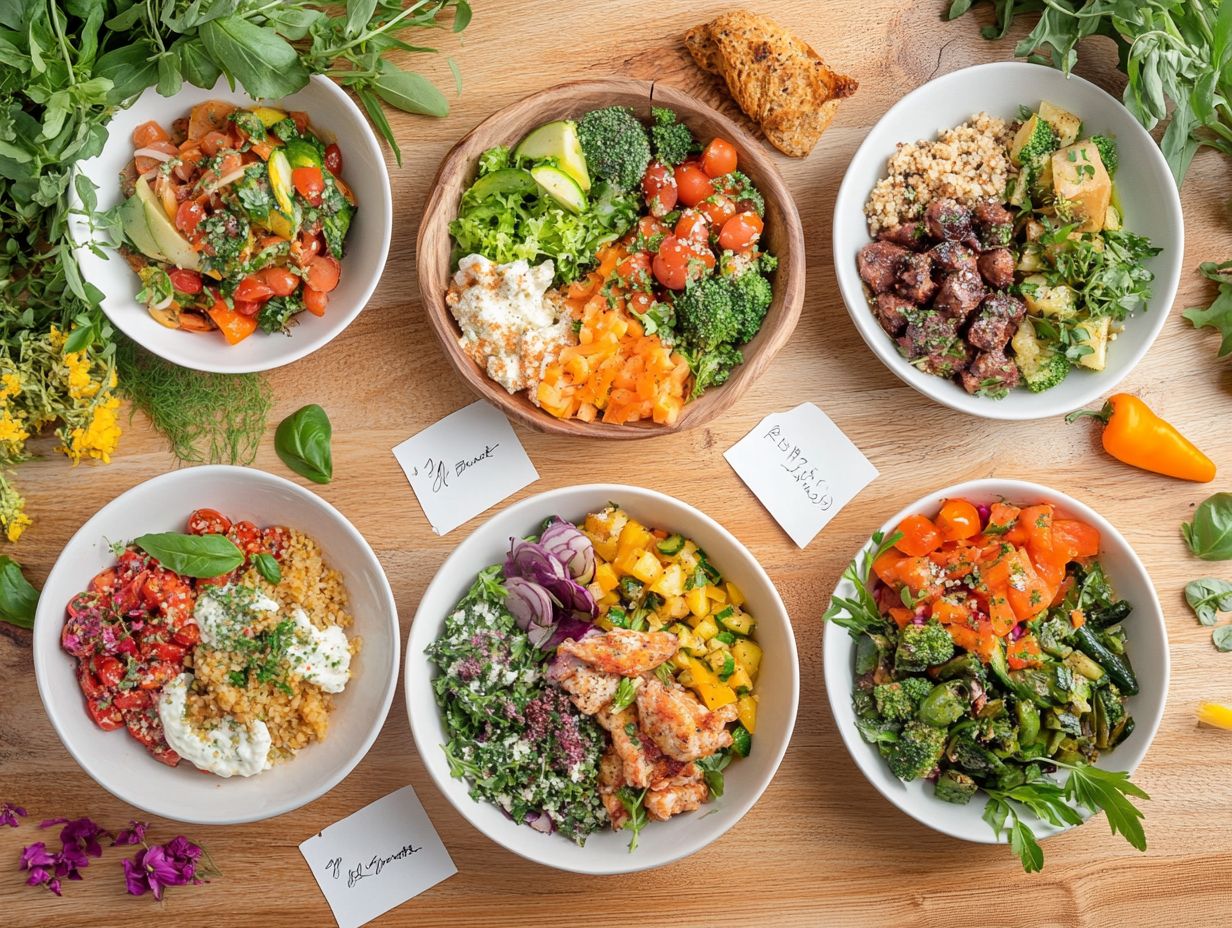
What are low-gluten recipes for healthier eating?
Low-gluten recipes contain significantly less gluten than traditional recipes. Gluten is a protein in wheat, barley, and rye, and it can cause digestive issues for some people. Limiting gluten can improve digestion and overall health.
Why should I consider incorporating low-gluten recipes into my diet?
Eating a low-gluten diet can improve digestive issues, gut health, sleep, and energy levels. It’s beneficial for those with gluten sensitivities or celiac disease.
What types of ingredients are used in low-gluten recipes?
Low-gluten recipes often use alternative flours like almond, coconut, or quinoa flour instead of wheat flour. They also incorporate fruits, vegetables, and lean proteins for balanced meals.
Are these recipes suitable for those with celiac disease?
While these recipes are lower in gluten, they may still contain small amounts and may not be suitable for those with celiac disease. Always consult with a healthcare professional before making significant dietary changes.
Ready to explore low-gluten recipes? Consult with your healthcare provider and try these delicious options today!
Can these recipes help with weight loss?
Low-gluten recipes can support weight loss when added to a balanced diet. They are often lower in calories, encouraging healthier food choices.
Do these recipes sacrifice flavor for health?
No way! These recipes are both healthy and delicious. Alternative flours, herbs, and spices enhance flavor, making them just as tasty as regular gluten-filled dishes.


